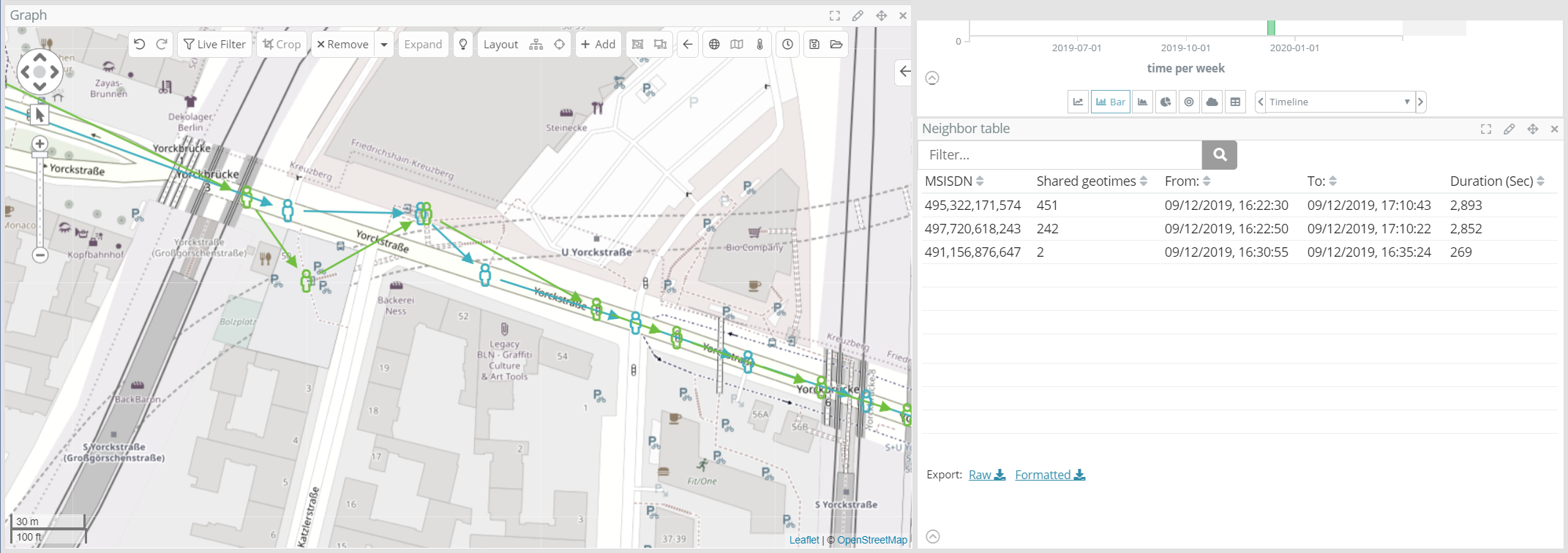I have recently learned that a Siren deployment, typically used for national security, has been instead heavily in use for fighting COVID-19 spread in the customer’s country.
In the days of COVID-19 the customer, like many others, quickly took the decision to track COVID-19 cases and perform “contact tracing” using the same technologies.
By determining the whereabouts of possibly infected persons and who they may have spent considerable time with, recommendations for self-isolation were issued and tests were scheduled. As of today, the country’s efforts seem to have paid off.
In this article, we’ll see some of the factors that affect contact tracing and how it will likely evolve – along with what Siren can do for contact tracing in general.
What is it (and does it really work)?
The purpose of contact tracing is to find and possibly notify citizens who might be at high risk of COVID-19 infection. This is done on the principle that high-risk people are those who have been within two meters for 15 minutes or more, with a known infected person in the last four weeks (from current HSE guidelines).
The guidelines also clarify that we’re not looking for people that we casually passed on the street, as the probability, in this case, is very low.
Does it really work?
One can legitimately ask: with a virus that is symptomatic only in a relatively small fraction of the cases, does contact tracing really work?
It turns out that yes, at scale tracing can work for COVID-19 and similar viruses.
This very recent article (Science) simulates the effects of contact tracing to show that it has the potential to stop and revert the growth curve of a virus such as COVID-19.
In the chart below, when a fully-automated system is mass deployed, the epidemic dynamic enters the decreasing “green area” (top right for the colorblind like me) even when one can’t quite perfectly determine positive cases or contacts (60% precision in each).
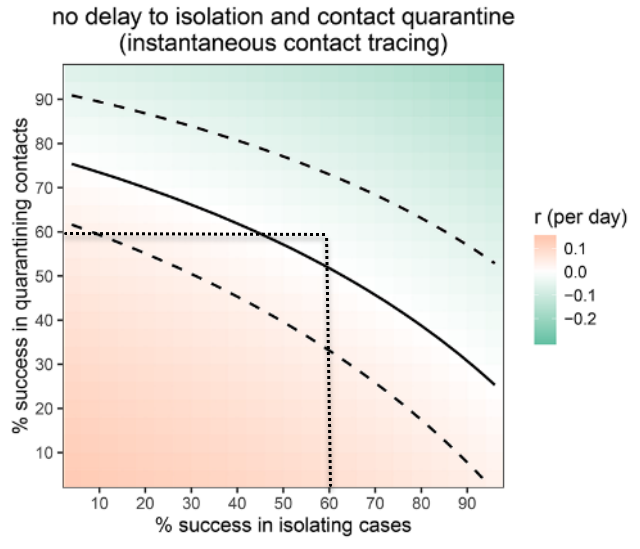
Note that the paper does not specify what technological principle tracing should rely on (mobile phone app, mass phone location tracing, etc.), which prompts the next question.
What tech options are out there for contact tracing?
There are really many ways to geolocate people, some extending to really Orwellian extremes and some being quite clever, e.g. like inferring that two people might have been in contact as they sent traffic from the same IP associated with a small office.
For tracing to work well, however, the methods need to work at scale and, the way I see it, there are really two possible approaches:
- Mobile phone operator data
- Specialized apps for low-distance contact detection
About mobile phone operator data; there is a widespread belief that operators have the position of their subscribers at any time but this is not true, in a lot of cases.
On the one hand, technically, mobile phone operators could upgrade their operations support systems with software that use antenna telemetry – continuous power reading from the many antennas that talk to the same 3g/4g handset at the same time – to ultimately determine an approximate location for each subscriber (100m is a good guess).
The reality is, however, that operators typically don’t do that unless mandated by legislation and instead limit themselves to providing “cell tower” data, i.e. the coordinates of the nearest phone antenna.
Other technical solutions exist that can (in a way) bypass mobile phone operators and still get at a scale similar if not better precision, but they fall within the realm of intelligence and are likely to face opposition if better methods are not available.
Technically speaking, mobile phone apps are in theory the best possible sources for contact tracing information: they have access to the most precise positioning (typically via a blend of GPS, wifi and other information) and not least have bluetooth capabilities, these possibly offering the greatest balance between privacy and effectiveness.
But even with apps as the source, the data is far from being perfect or easy to interpret. Bluetooth contact lists can be endless, and GPS data requires careful processing to extract the signal from noise – quite literally.
See below a screenshot from an exercise in COVID-19 contact tracing with Siren using anonymized, commercially available, mixed GPS/phone positioning data. As we can see, the tracks are far from precise, but signal processing does make “top candidates” stand out.
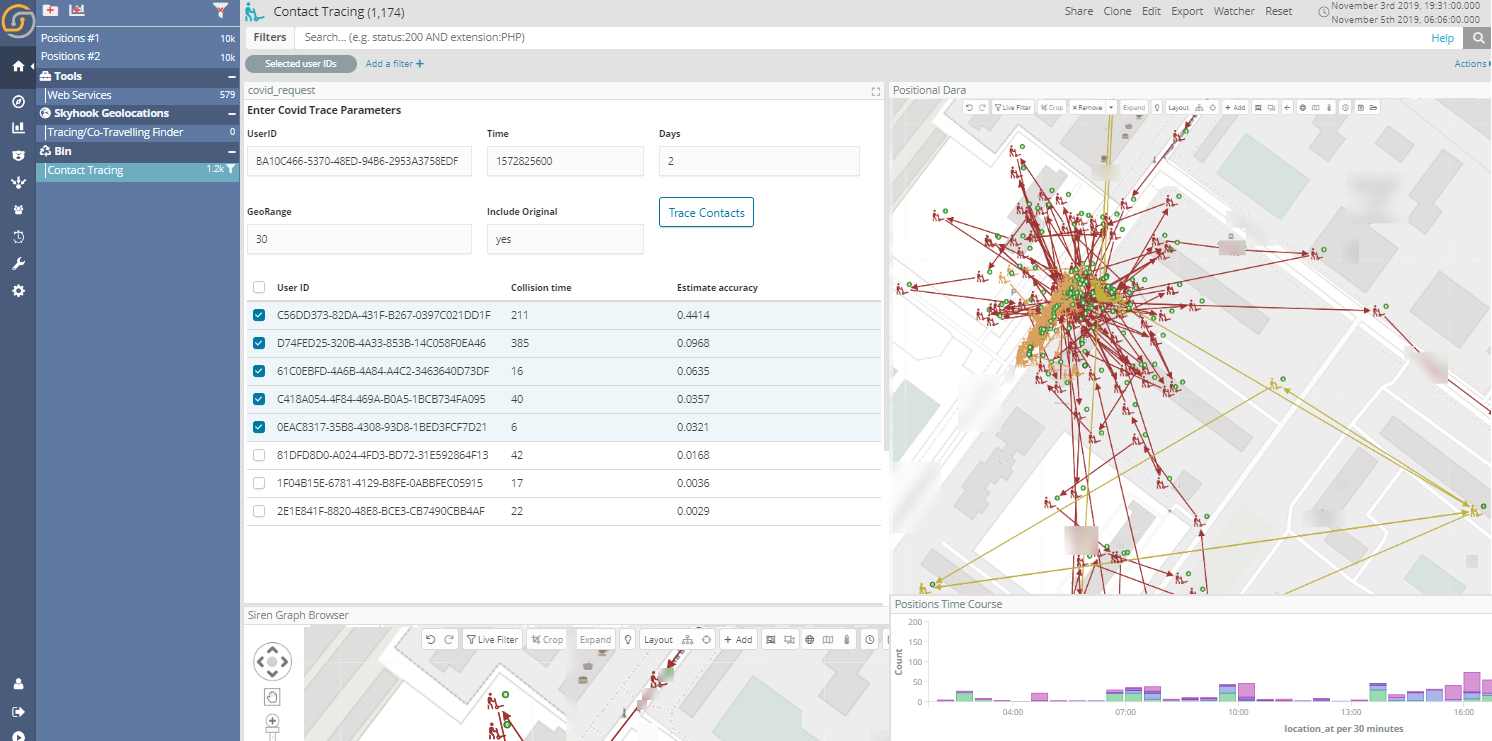
But will your population cooperate?
The problem with apps is that it typically requires the cooperation of people: people need to both download the app and agree on using the same one (and there are so many really).
While this might not be a problem in countries like China – where the app was simply pushed down as an update of ubiquitous payment and chat apps – it will be in many other countries for which telecom data at scale might be the route of choice.
What can Siren do for Contact Tracing?
Siren is focused on targeting new challenges very quickly.
Thanks to the new “scripting” and “webservice” features in the forthcoming Siren 10.5, it took us approximately 48 hours to create a COVID specific deployment with easy workflows for operators.
The deployment (here shown on simulated data) takes positions streaming from phones (We assume mixed GPS/3G accuracy) or bluetooth contacts.
It then allows:
- For each infected person, determine a list of meetings up to 2 weeks in the past.
- For each meeting: estimated duration, an estimated accuracy and – if subscriber info is available – an indication of the age of the person met allowing to prioritize checks for elderly people.
Tracks can be visualized specifically for manual verification.
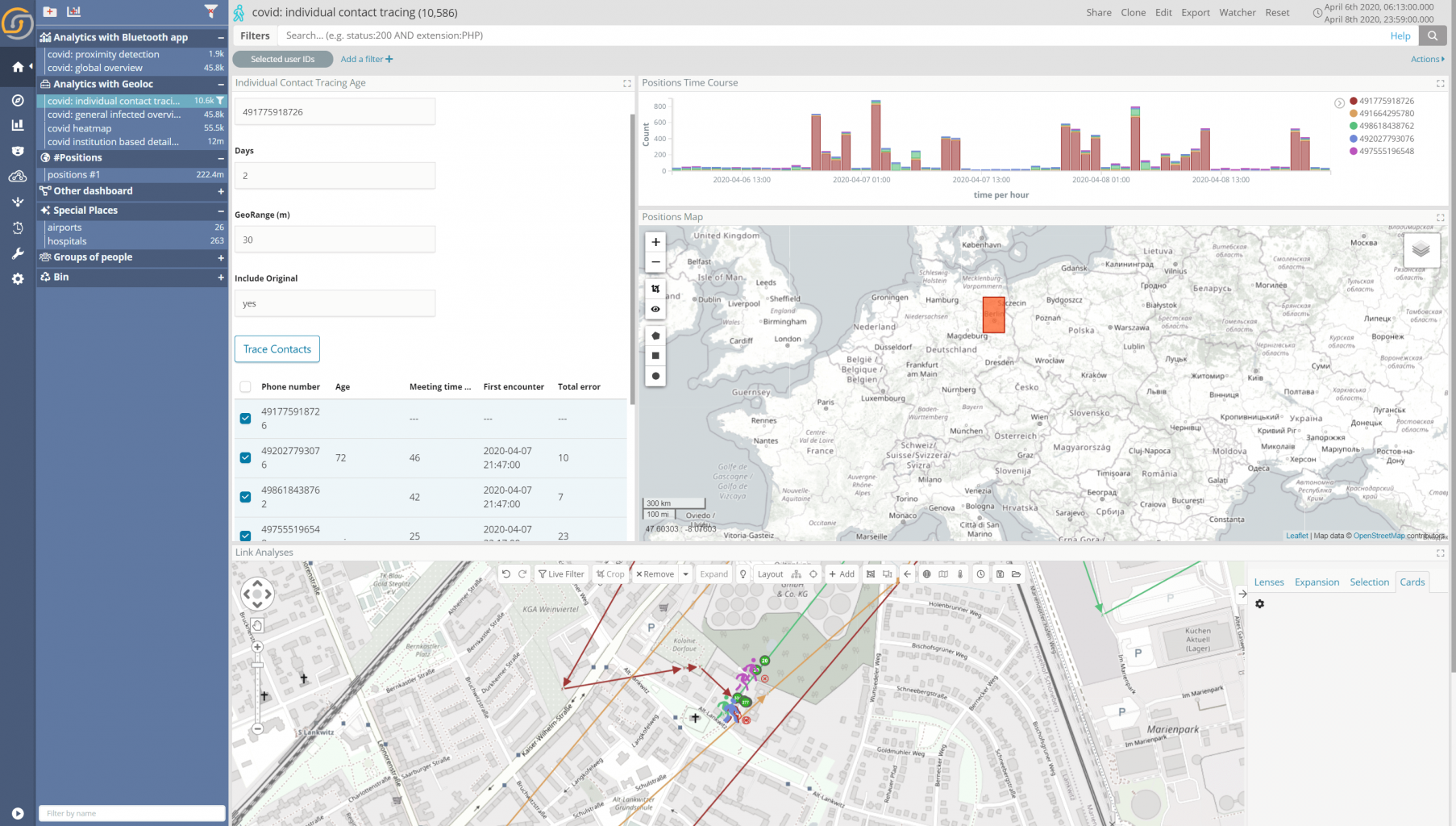
But the system works also at full country scale. Every night it produces a report. Here is the one from yesterday, reporting:
- People most at risk yesterday (having been close to several covid infected)
- People which are now confirmed COVID and have been in touch with most people (e.g. they could be working in close contact with many people daily).
Every dashboard allows drill downs to focus on specific people, cases, or locations. (Technically, the fusion of different indexes in the same dashboard is supported by our dashboard 360 feature)
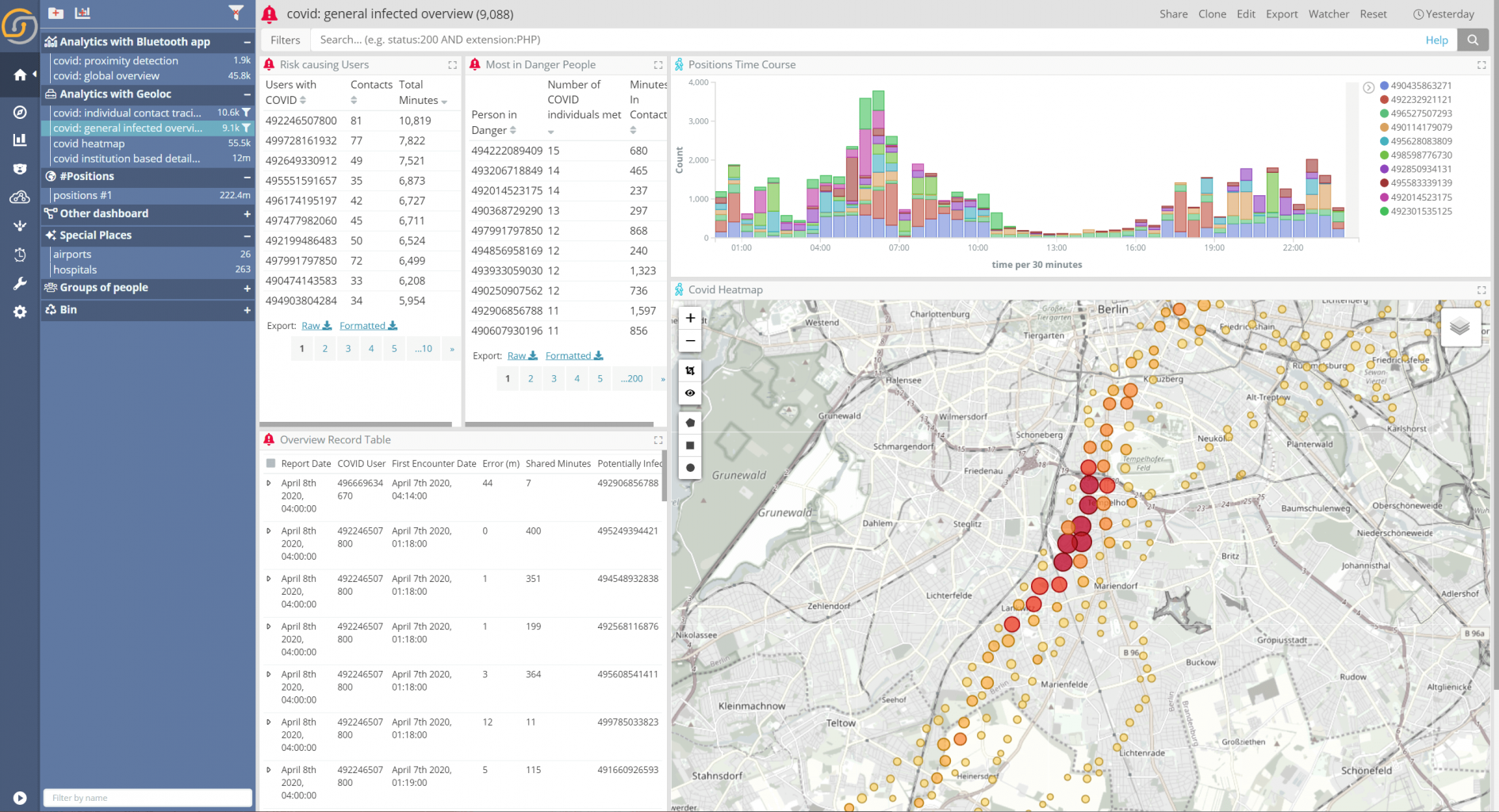
From emergency contact tracing to “Smart Social Distancing”
As the COVID-19 crisis stabilizes, the efforts will likely shift from emergency first responses, where intelligence-grade technologies have also been employed, to a stable and sustainable future which preserves privacy as a prime value.
The APIs drafted by Google and Apple for privacy preserving Bluetooth tracing will likely become a widespread base standard, likely also to be complemented by additional data sources or methods at least in certain countries/contexts.
Possibly the term you’ll hear the most in the future is “Smart Social Distancing” referring to a combination of technology, AI, and sensible citizen behavior that will likely become the norm for a good while to overcome the COVID-19 crisis, but also to not be unprepared for similar future threats.
Meanwhile, at Siren, we are very proud to have already done our part at least in the early phase of this crisis.
Furthermore, we are now making this technology available for free for 6 months to qualifying institutions. Please contact us for more info.



